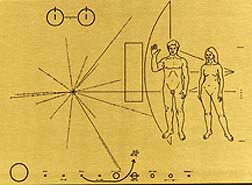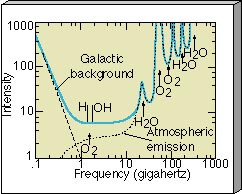Let us continue our optimistic assessment of the prospects for life and assume that civilizations enjoy a long stay on their parent planet once their initial technological "teething problems" are past. In that case, they are likely to be plentiful in the Galaxy. How might we become aware of their existence?
For concreteness, let us assume that the average lifetime of a technological civilization is 1 million years—only 1 percent of the reign of the dinosaurs, but 100 times longer than human civilization has survived thus far. Given the size and shape of our Galaxy, we can then estimate the average distance between these civilizations to be some 50 pc, or about 150 light years. Thus, any two-way communication with our neighbors—using signals traveling at or below the speed of light—will take at least 300 years (150 years for the message to reach the planet and another 150 years for the reply to travel back to us).
One obvious way to search for extraterrestrial life would be to develop the capability to travel far outside our solar system. However, this may never be a practical possibility. At a speed of 50 km/s, the speed of the current fastest unmanned space probes, the trip to our nearest neighbor, Alpha Centauri, would take about 25,000 years. The journey to the nearest civilization (assuming, as earlier, that a total of 1 million such cultures exist in the Galaxy) would take almost 1 million years. Interstellar travel at these speeds is clearly not feasible. Speeding up our ships to near the speed of light would reduce the travel time, but this is far beyond our present technology.
Actually, our civilization has already launched some interstellar probes, although they have no specific stellar destination. Figure 28.10 is a reproduction of a plaque mounted onboard the Pioneer 10 spacecraft launched in the mid-1970s and now well beyond the orbit of Pluto, on its way out of the solar system. Similar information was also included aboard the Voyager probes launched in 1978. Although these spacecraft would be incapable of reporting back to Earth the news that they had encountered an alien culture, scientists hope that the civilization on the other end would be able to unravel most of its contents using the universal language of mathematics. The caption to Figure 28.10 notes how the aliens might discover from where and when the Pioneer and Voyager probes were originally launched.

Figure 28.10 A replica of a plaque mounted on board the Pioneer 10 spacecraft. The important features of the plaque include a scale drawing of the spacecraft, a man, and a woman; a diagram of the hydrogen atom undergoing a change in energy (top left); a starburst pattern representing various pulsars and the frequencies of their radio waves that can be used to estimate when the craft was launched (middle left); and a depiction of the solar system, showing that the spacecraft departed the third planet from the Sun and passed the fifth planet on its way into outer space (bottom). All the drawings have computer- (binary) coded markings from which actual sizes, distances, and times can be derived.
Setting aside the many practical problems of establishing direct contact with extraterrestrials, some scientists have argued that it might not even be a particularly good idea. Our recent emergence as a technological civilization implies that we must be one of the least advanced technological intelligences in the entire Galaxy. Any other civilization that we discover, or that discovers us, will almost surely be more advanced than us. Consequently, a healthy degree of caution is warranted. If extraterrestrials behave even remotely like human civilizations on Earth, then the most advanced aliens may naturally try to dominate all others. The behavior of the "advanced" European cultures toward the "primitive" races they encountered on their voyages of discovery in the seventeenth, eighteenth, and nineteenth centuries should serve as a clear warning of the possible undesirable consequences of contact. Of course, the aggressiveness of Earthlings may not apply to extraterrestrials, but given the history of the one intelligent species we know, the cautious approach may be in order.
A cheaper, and much more practical, alternative is to try to make contact with extraterrestrials using only electromagnetic radiation, the fastest known means of transferring information from one place to another. Because light and other high-frequency radiation are heavily scattered while moving through dusty interstellar space, long-wavelength radio radiation seems to be the natural choice. We would not attempt to broadcast to all nearby candidate stars, however—that would be far too expensive and inefficient. Instead, radio telescopes on Earth would listen passively for radio signals emitted by other civilizations. Some preliminary searches of selected nearby stars are now under way, thus far without success.
In what direction should we aim our radio telescopes? The answer to this question at least is fairly easy. On the basis of our earlier reasoning, we should target all F-, G-, and K-type stars in our vicinity. But are extraterrestrials broadcasting radio signals? If they are not, this search technique will obviously fail. If they are, how do we distinguish their artificially generated radio signals from signals naturally emitted by interstellar gas clouds? At what frequency should we tune our receivers? This depends on whether the signals are produced deliberately or are simply "waste radiation" escaping from a planet.
Consider how Earth would look at radio wavelengths to extraterrestrials. Figure 28.11 shows the pattern of radio signals we emit into space. From the viewpoint of a distant observer, the spinning Earth emits a bright flash of radio radiation every few hours. In fact, Earth is now a more intense radio emitter than the Sun. The flashes result from the periodic rising and setting of hundreds of FM radio stations and television transmitters. Each station broadcasts mostly parallel to Earth's surface, sending a great "sheet" of electromagnetic radiation into interstellar space, as illustrated in Figure 28.11(a). (The more common AM broadcasts are trapped below our ionosphere, so those signals never leave Earth.)

Figure 28.11 Radio radiation now leaks from Earth into space because of the daily activities of our technological civilization. (a) FM radio and television transmitters broadcast their energy parallel to Earth's surface, so they send a great "sheet" of electromagnetic radiation into interstellar space, producing the strongest signal in any given direction when they happen to lie on Earth's horizon, as seen from that direction. (The more common AM broadcasts are trapped below our ionosphere, so those signals never leave Earth.) (b) Because the great majority of transmitters are clustered in the eastern United States and western Europe, a distant observer would detect blasts of radiation from Earth as our planet rotates each day.
Because the great majority of these transmitters are clustered in the eastern United States and western Europe, a distant observer would detect blasts of radiation from Earth as our planet rotates each day (Figure 28.11b). This radiation races out into space, and has been doing so since the invention of these technologies nearly seven decades ago. Another civilization as advanced as ours might have constructed devices capable of detecting this radiation. If any sufficiently advanced (and sufficiently interested) civilization resides on a planet orbiting any of the thousand or so stars within about 65 light years (20 pc) of Earth, then we have already broadcast our presence to them.
Now let us suppose that a civilization has decided to assist searchers by actively broadcasting its presence to the rest of the Galaxy. At what frequency should we listen for such an extraterrestrial beacon? The electromagnetic spectrum is enormous; the radio domain alone is vast. To hope to detect a signal at some unknown radio frequency is like searching for a needle in a haystack. Are some frequencies more likely than others to carry alien transmissions?
Some basic arguments suggest that civilizations might well communicate at a wavelength near 20 cm. As we saw in Chapter 18, the basic building blocks of the universe, namely, hydrogen atoms, naturally radiate at a wavelength of 21 cm. (Sec. 18.4) Also, one of the simplest molecules, hydroxyl (OH), radiates near 18 cm. Together, these two substances form water (H2O). Arguing that water is likely to be the interaction medium for life anywhere and that radio radiation travels through the disk of our Galaxy with the least absorption by interstellar gas and dust, some researchers have proposed that the interval between 18 and 21 cm is the best wavelength range for civilizations to transmit or monitor. Called the water hole, this radio interval might serve as an "oasis" where all advanced Galactic civilizations would gather to conduct their electromagnetic business.
This water-hole frequency interval is only a guess, of course, but it is supported by other arguments as well. Figure 28.12 shows the water hole's location in the electromagnetic spectrum and plots the amount of natural emission from our Galaxy and from Earth's atmosphere. The 18- to 21-cm range lies within the quietest part of the spectrum, where the Galactic "static" from stars and interstellar clouds happens to be minimized. Furthermore, the atmospheres of typical planets are also expected to interfere least at these wavelengths. Thus the water hole seems like a good choice for the frequency of an interstellar beacon, although we cannot be sure of this reasoning until contact is actually achieved. A few radio searches are now in progress at frequencies in and around the water hole. So far, however, nothing resembling an extraterrestrial signal has been detected.

Figure 28.12 The "water hole" is bounded by the natural emission frequencies of the hydrogen (H) atom (21-cm wavelength) and the hydroxyl (OH) molecule (18-cm wavelength). The topmost solid (blue) curve sums the natural emissions of our Galaxy (dashed line on left side of diagram) and Earth's atmosphere (dotted line on right side of diagram denoted by various chemical symbols). This sum is minimized near the water-hole frequencies. Perhaps all intelligent civilizations conduct their interstellar communications within this quiet "electromagnetic oasis."
The space surrounding all of us could be, right now, flooded with radio signals from extraterrestrial civilizations. If only we knew the proper direction and frequency, we might be able to make one of the most startling discoveries of all time. The result would likely provide whole new opportunities to study the cosmic evolution of energy, matter, and life throughout the universe.